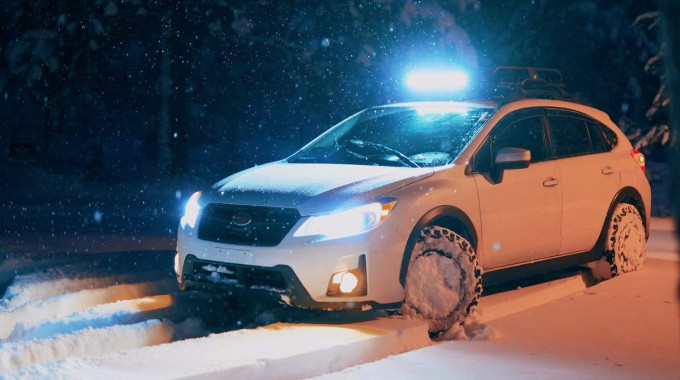
5 Great Ways to Protect Your Car From Wintertime Damage
Your car is one of the biggest investments you’ll ever make—and taking steps to protect it from the ravages of the winter travel season in Canada is a smart way to help maintain your car’s residual value for the long term, while maximizing your enjoyment of it along the way.
Here’s our story on residual value and how to calculate it.
In most parts of the country, our cars have a rough life, spending months every year driven in extreme cold while being blasted with abrasive sand, sprayed and soaked with corrosive salt water, and being forced to work while packed full of snow and ice and slush.
Wintertime is hard on your vehicle’s body, electronics, mechanicals, and even finish. Below? We’ll dig into 5 ways to protect your car from wintertime damage.
Salt eliminator treatment
Today, many municipalities are using harsher and more corrosive chemicals and substances to keep roadways clear in wintertime. De-icing agents can invite premature corrosion of even the most modern vehicles, and tackifiers used to make road salt ‘stick’ to road surfaces ahead of snowstorms mean that same salt also sticks more effectively to the underside of your car, where it invites expensive, damaging rust.
A salt eliminator treatment can help protect your ride from the corrosive ravages of winter driving, by professionally cleaning the underside of your ride with a special product that dismantles the molecular bond between salt and the body of your car.
Far more effective than rinsing with water, salt eliminator treatments have been around for years in industrial applications, and have now been adapted for use in passenger vehicles.
Ideally used just ahead of a rust inhibitor application, salt eliminator treatments help ensure a rust-free ride for years to come
Rust inhibitor
For most Canadians, having a regular rust inhibitor treatment applied about once a year is a great way to fend off wintertime damage caused by rust and protect your investment.
Ideally applied after a salt eliminator treatment, professional rust inhibitors are applied to form a physical barrier between corrosive salt spray and the body and parts of your car.
This treatment should be applied on a yearly basis, and generally costs less than $200.
By the way, achieving top resale value for your car when you sell it or trade it in requires no visible rust to be present—meaning that a reputable rust inhibitor applied yearly can literally save you thousands of dollars when it’s time to trade in your ride.
If rustproofing your ride is on the to-do list, also read our article: Importance of Rustproofing & 3 Car Rust Protection Treatments.
Clearing ice
Look, we get it: it’s 25 below, you’re late for work, and removing the ice build up from your frozen Jetta at 6:15 am is nobody’s favourite task. Just be careful, since aggressive or rushed ice and snow clearing from your car is a key cause of damage to finishes and glass.
Avoid the temptation to hack, chisel, chip or break away at ice that’s frozen onto your car’s paint or glass surfaces, as this can cause chipping, marking, and other damage. Avoid using your windshield wipers while they’re frozen to the windscreen, which can cause them to rip, tear, and split.
Especially with a convertible roof, be sure not to hammer or chip away at ice buildup. Clear frozen windows carefully, and avoid forcing frozen door handles and power windows to prevent wear and damage, too.
If you’re tempted to pour warm water onto your frozen windscreen to accelerate defrosting, don’t: that’s a great way to split your windshield in half.
Floor liners
Precise-fit, custom-made floor liners are available from brands like Husky and WeatherTech, and they’re worth their weight in gold when it comes to the long-term resale value and appearance of your car or truck.
Not only do custom-fit floor liners mean you won’t have to spend half your springtime scrubbing salt-rocks out of your carpeting, they also prevent that abrasive and corrosive mixture of melted slush and sand from seeping into your carpet where it can cause odors, mould, and even rust to the body beneath.
Best of all, you can clean your floor liners of a winter’s worth of mess in about 3 minutes with a garden hose in your driveway.
Exterior accessories
The clever use of a few widely-available accessories can help protect vulnerable parts of your car’s body and paint from damage and wear that’s increasingly likely in winter driving.
For instance, a hood-edge deflector can protect this easily-damaged part of your vehicle from chips caused by sand and salt, while factory mud-flaps tame flying ice and slush that’ll otherwise be in constant contact with the underside of your wheel wells and rocker panels.
Protective adhesive films can be applied to specific areas of some cars by qualified installers, forming a thin but crystal-clear barrier between vulnerable paint and the elements, for a cleaner look. This protective film can be applied over headlights, mirror caps, body panels, hood edges, and more.
A water-repelling product like ITEKT can be applied to your windshield, increasing visibility in winter driving and reducing wear on wiper blades.







